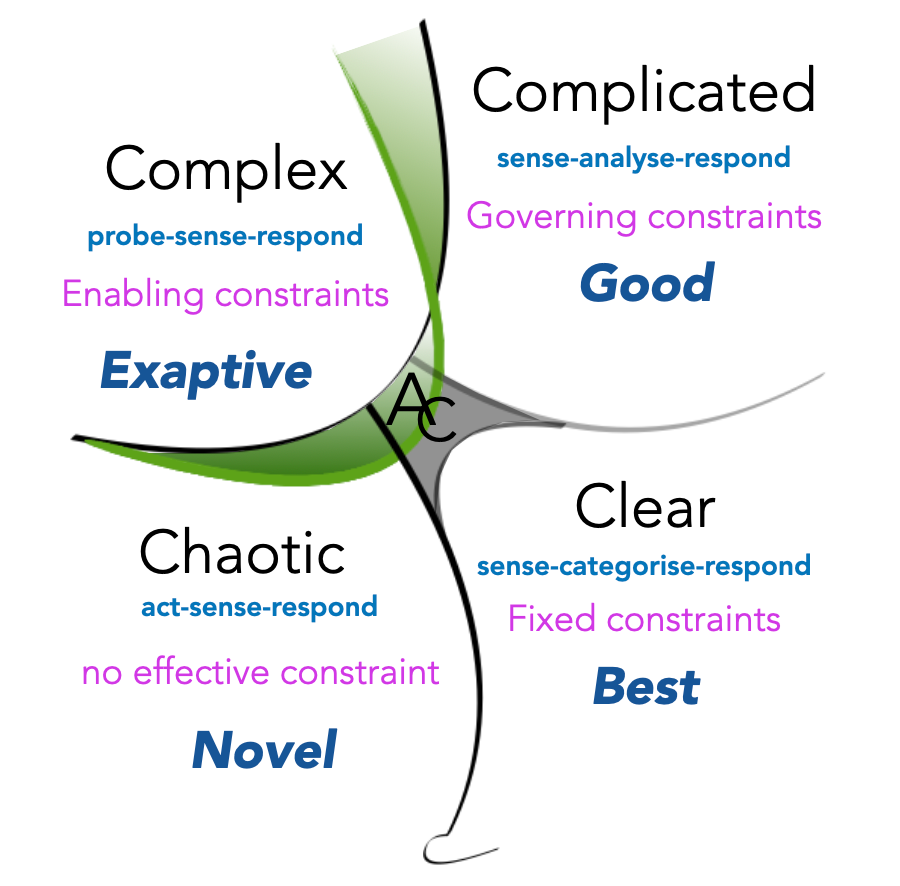Professional Improvement
My last professional training, until recently, was a research retreat to Nepal in 2020, with Jan Chipchase’s Studio D. Since then, I have been working, reading, listening, reflecting, speaking, and writing. Except perhaps for speaking, these activities are table stakes for steady, self-directed professional growth.
Training helps, and the extended masterclass format offers a punctuated equilibrium. It is a burst of concentrated knowledge and theory that, if harvested and re-incorporated into practice, yields outsized and long-standing results. I've recently attempted to do just that with two Cynefin Co. masterclasses on Complexity and Estuarine Mapping.
Three Threads to Pull
Here are three broad threads from those sessions, among others, that fit our direction of travel. (I’ll save “Stop goal directed behavior” and “Hold ambiguity for as long as possible” for later editions of LC.)
I. Make decisions according to domain
Dave Snowden’s Cynefin (pronounced “kuh-nev-in”) framework offers an elegant distinction between various decision-making domains. It shows what kind of constraints we’re operating with, and how our decisions ought to respond in each of them.

The ordered domains (right), Clear and Complicated, have straightforward relationships between cause and effect. We determine what is going on before we take action. They’re places for well-defined best practices, expert analysis, and methodical action. Big, planned projects make sense. Working here is akin to acting in the more evolved, late-stage product and commodity spaces on a Wardley Map.
The unordered domains (left), Complex and Chaotic, do not have straightforward cause-and-effect relationships. In the Complex domain, if we act on a Complex Adaptive System (CAS), we probe or poke or stimulate the thing to see what happens — to see where the energy flows and what possibilities are available— before we can decide where to invest our effort. In the Chaotic domain, without any governing constraints, we must act and create constraints to stabilize the situation. (Consider the political benefit of manufactured chaos: the situation requires forceful action that appears appropriate at the moment, but would be draconian in any other situation.) Decision-making in these domains is akin to acting in the less-evolved spaces on your Wardley Map — custom-building solutions can be complex affairs; the genesis of new activity is one form of chaos.
Get to good granularity
When we are working with decisions or opportunities, we can assess their domain of order using Cynefin, or map the time-and-energy cost of change using the Estuarine framework. This is, again like Wardley Mapping, remarkably simpler than it seems, once one builds the gumption to try it and then try again.
But we have to work at the right granularity. Groups that cannot quickly agree on the domain of decision, or the time and energy cost of an opportunity, are likely working at the wrong granularity. This was a recurring theme in both Cynefin Co masterclasses: “break it down until everyone agrees!” Don’t discuss it, just break the idea down further into smaller components that continue to capture the essence of what is being discussed, but become more concrete and granular.
This exhortation was accompanied by examples of evolutionary exaptation: small, existing capabilities are radically repurposed and drive new innovation. Birds emerge from tree-dwelling dinosaurs equipped with feathers purely for warmth. If we are to cultivate such emergence in a human system, we need to understand our capabilities at the right level so we can re-purpose them in times of need. We won’t see them if we talk above them or around them, or remain in the realm of the vague and generic.
It’s an excellent sensibility to bring to most arguments and exercises: wherever ideas, opportunities, or existing capabilities are being enumerated.
Work with what the substrate affords
As people working together in organizations, we are a part of a complex and interconnected substrate, a fabric that supports and contains and constrains our action. I find here a lovely parallel with Christopher Alexander’s wholeness or “field of centers” to describe the structural reality we inhabit and operate on. Snowden draws on Gibson’s idea of affordances — those things we can get a handle on — to describe those parts of the substrate we can see, move, monitor, and manage.
Those things will differ depending on who is looking at them and what they understand is possible. We can grow our optionality by creating a richer shared view of the substrate. Many Cynefin Co methods do just that, as does Wardley mapping, and it’s what we’ve touched on in LC11 Frame Control.
Coupled to this theme is a rejection of the current state of systems thinking: we cannot and will not ever model the system in its entirety if we are working in a complex domain. To imagine that we are identifying its major causal loops and all of the key relationships at play is to mistake the unordered complexity for a situation of order. The best approach (and the root of all good strategy) is to understand the nature of our situation and the forces at play, and then to be very clear about what is within our scope of control.
Other things of note
- I’ll extend and explore the implications of these ideas in research, specifically, in a free Rosenfeld Media video call in two weeks (Wednesday, August 27th). Sign up and join — if you don’t like it, you can always leave!
- So many threads in Dave Snowden’s thinking parallel those in Simon Wardley’s. In Copenhagen, I asked Dave about this apparent convergence and he said it should not be surprising: he and Simon take similar paths, and both of them have drawn on Max Boisot's very influential I-Space, a framework I’m not yet so familiar with.
- As of September, DRC will turn five years old. I won’t work the wine harvest this year as I’ve already spent January as a sake-brewing intern. Instead I’ll make a different kind of harvest: Monday begins a six-week writing sabbatical.


![Complexity Threads [LC28]](/content/images/size/w100/2025/08/PXL_20250803_111713683-1.jpg)
